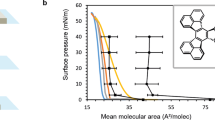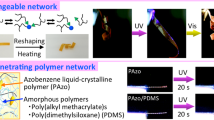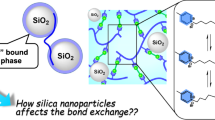Abstract
Nature abounds with intricate composite architectures composed of hard and soft materials synergistically intertwined to provide both useful functionality and mechanical integrity. Recent synthetic efforts to mimic such natural designs have focused on nanocomposites1,2,3,4,5, prepared mainly by slow procedures like monomer or polymer infiltration of inorganic nanostructures6,7 or sequential deposition8,9. Here we report the self-assembly of conjugated polymer/silica nanocomposite films with hexagonal, cubic or lamellar mesoscopic order using polymerizable amphiphilic diacetylene molecules as both structure-directing agents and monomers. The self-assembly procedure is rapid and incorporates the organic monomers uniformly within a highly ordered, inorganic environment. Polymerization results in polydiacetylene/silica nanocomposites that are optically transparent and mechanically robust. Compared to ordered diacetylene-containing films prepared as Langmuir monolayers10 or by Langmuir–Blodgett deposition10, the nanostructured inorganic host alters the diacetylene polymerization behaviour, and the resulting nanocomposite exhibits unusual chromatic changes in response to thermal, mechanical and chemical stimuli. The inorganic framework serves to protect, stabilize, and orient the polymer, and to mediate its function. The nanocomposite architecture also provides sufficient mechanical integrity to enable integration into devices and microsystems.
This is a preview of subscription content, access via your institution
Access options
Subscribe to this journal
Receive 51 print issues and online access
$199.00 per year
only $3.90 per issue
Buy this article
- Purchase on Springer Link
- Instant access to full article PDF
Prices may be subject to local taxes which are calculated during checkout




Similar content being viewed by others
References
Dagani, R. Putting the “nano” into composites. Chem. Eng. News 77, 25–37 (1999).
Giannelis, E. Polymer layered silicate nanocomposites. Adv. Mater. 8, 29–35 (1996).
Asefa, T., Yoshina-Ishii, C., MacLachlan, M. J. & Ozin, G. A. New nanocomposites: putting organic function “inside” the channel walls of periodic mesoporous silica. J. Mater. Chem. 10, 1751–1755 (2000).
Smith, R. C., Fischer, W. M. & Gin, D. L. Ordered poly(p-phenylenevinylene) matrix nanocomposites via lyotropic liquid-crystalline monomers. J. Am. Chem. Soc. 119, 4092–4093 (1997).
Sellinger, A. et al. Continuous self-assembly of organic-inorganic nanocomposite coatings that mimic nacre. Nature 394, 256–260 (1998).
Moller, K., Bein, T. & Fischer, R. X. Entrapment of PMMA polymer strands in micro- and mesoporous materials. Chem. Mater. 10, 1841–1852 (1998).
Nguyen, T.-Q., Wu, J., Doan, V., Schwartz, B. J. & Tolbert, S. H. Control of energy transfer in oriented conjugated polymer-mesoporous silica composites. Science 288, 652–656 (2000).
Kleinfeld, E. R. & Ferguson, G. S. Stepwise formation of multilayered nanostructural films from macromolecular precursors. Science 265, 370–373 (1994).
Keller, S. W., Kim, H.-N. & Mallouk, T. E. Layer-by-layer assembly of intercalation compounds and heterostructures on surfaces: Toward molecular “beaker” epitaxy. J. Am. Chem. Soc. 116, 8817–8818 (1994).
Sasaki, D. Y., Carpick, R. W. & Burns, A. R. High molecular orientation in mono- and trilayer polydiacetylene films imaged by atomic force microscopy. J. Colloid Interf. Sci. 229, 490–496 (2000).
Charych, D., Nagy, J., Spevak, W. & Bednarski, M. Direct colorimetric detection of a receptor-ligand interaction by a polymerized bilayer assembly. Science 261, 585–588 (1993).
Cheng, Q. & Stevens, R. Charge-induced chromatic transition of amino acid-derivatized polydiacetylene liposomes. Langmuir 14, 1974–1976 (1998).
Cheng, Q., Yamamoto, M. & Stevens, R. Amino acid terminated polydiacetylene lipid microstructures: morphology and chromatic transition. Langmuir 16, 5333-5342 (2000).
Mazumdar, S. Prospects for the polymer nanoengineer. Science 288, 630–631 (2000).
Lu, Y. F. et al. Continuous formation of supported cubic and hexagonal mesoporous films by sol–gel dip coating. Nature 389, 364–368 (1997).
Israelachvili, J. N. Intermolecular and Surface Forces Ch. 17 (Academic, San Diego, 1992).
Monnier, A. et al. Cooperative formation of inorganic-organic interfaces in the synthesis of silicate mesostructures. Science 261, 1299–1303 (1993).
Day, D. & Ringsdorf, H. Polymerization of diacetylene carbonic acid monolayers at the gas-water interface. J. Polym. Sci. Polym. Lett. Edn 16, 205–210 (1978).
Gaines, G. L. (ed.) in Insoluble Monolayers at Liquid-Gas Interfaces 281–300 (John Wiley, New York, 1966).
Menzel, H., Mowery, M. D., Cai, M. & Evans, C. E. Vertical positioning of internal molecular scaffolding within a single molecular layer. J. Phys. Chem. B 102, 9550–9556 (1998).
Collins, M. Optical-properties of poly-diacetylene monolayers. J. Polym. Sci. B 26, 367–372 (1988).
Kuriyama, K., Kikuchi, H. & Kajiyama, T. Molecular packings-photopolymerization behavior relationship of diacetylene Langmuir-Blodgett films. Langmuir 12, 6468–6472 (1996).
Spevak, W. et al. Polymerized liposomes containing C-glycosides of sialic acid: Potent inhibitors of influenza virus in vitro infectivity. J. Am. Chem. Soc. 115, 1146–1147 (1993).
Frankel, D. A. & O'Brien, D. F. Supramolecular assemblies of diacetylenic aldonamides. J. Am. Chem. Soc. 113, 7436–7437 (1991).
Frye, G. C., Ricco, A. J., Martin, S. J. & Brinker, C. J. in Mater. Res. Soc. (eds Brinker, C. J., Clark, D. E. & Ulrich, D. R.) 349–354 (Reno, Nevada, 1988).
Patel, G. N., Chance, R. R. & Witt., J. D. A planar-non-planar conformational transition in conjugated polymer solutions. J. Chem. Phys. 70, 4387–4392 (1979).
Burns, A. R., Carpick, R. W., Sasaki, D. Y. & Shelnutt, J. A. Mechanochromism, shear force anisotropy, and molecular mechanics in polydiacetylene monolayers. Tribol. Lett. (in the press).
Fan, H. et al. Rapid prototyping of patterned functional nanostructures. Nature 405, 56–60 (2000).
Brinker, C. J. Lu, Y., Sellinger, A. & Fan, H. Evaporation-induced self-assembly: nanostructures made easy. Adv. Mater. 11, 579–585 (1999).
Day, D. R. & Lando, J. B. Conduction in polydiacetylene bilayers. J. Appl. Polym. Sci. 26, 1605–1612 (1981).
Suzuoki, Y., Kimura, A. & Mizutani, T. in Proc. 7th Int. Symp. Electrets 850–855 (IEEE, New York, 1991).
Lu, Y. et al. Aerosol-assisted self-assembly of spherical, silica nanoparticles exhibiting hexagonal, cubic and vesicular mesophases. Nature 398, 223–226 (1999).
Acknowledgements
We thank J. Curro and F. van Swol for technical discussions and T. Bucheit for the nano-indentation results. This work was supported by the US Department of Energy Basic Energy Sciences Program, the Sandia National Laboratories Laboratory-Directed Research and Development Program, the National Aeronautics and Space Administration, the UNM/NSF Center for Micro-engineered Materials, and the Defense Advanced Research Projects Agency Bio-Weapons Defense Program. TEM investigations were performed in the Department of Earth and Planetary Sciences at the University of New Mexico. Sandia is a multiprogram laboratory operated by Sandia Corporation, a Lockheed-Martin Company, for the US DOE.
Author information
Authors and Affiliations
Corresponding author
Supplementary information
Rights and permissions
About this article
Cite this article
Lu, Y., Yang, Y., Sellinger, A. et al. Self-assembly of mesoscopically ordered chromatic polydiacetylene/silica nanocomposites. Nature 410, 913–917 (2001). https://doi.org/10.1038/35073544
Received:
Accepted:
Issue Date:
DOI: https://doi.org/10.1038/35073544
This article is cited by
-
Alert Patches Embedding Conjugated Polymeric Lamellar and Metal Nanoparticles Generating Optoelectronic Responses against Thermal Stresses
Macromolecular Research (2022)
-
Study of polydiacetylenes and rhodamine-800 mixed film at air–water interface and onto solid support: Trace of fluorescence resonance energy transfer (FRET)
Polymer Bulletin (2021)
-
Bis-ratiometric absorbance detection of Al(III) in the rhodamine B-functionalized bis-polydiacetylene film
Chemical Papers (2017)
-
Efficient copper-free aerobic alkyne homocoupling in polyethylene glycol
Environmental Chemistry Letters (2017)
-
A pure aqueous route to mesoporous silica thin films via dip-coating of prefabricated hybrid micelles
Journal of Sol-Gel Science and Technology (2017)
Comments
By submitting a comment you agree to abide by our Terms and Community Guidelines. If you find something abusive or that does not comply with our terms or guidelines please flag it as inappropriate.



